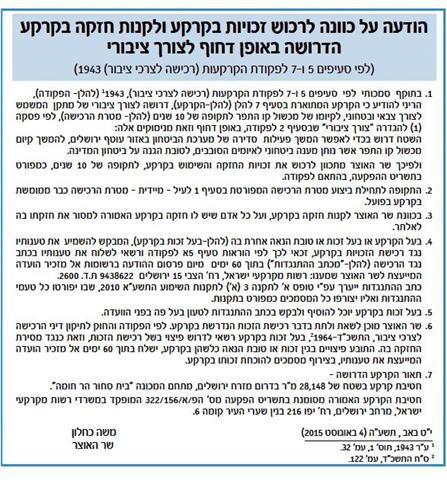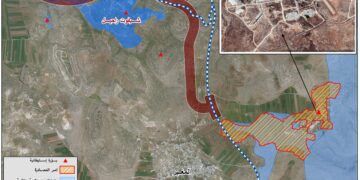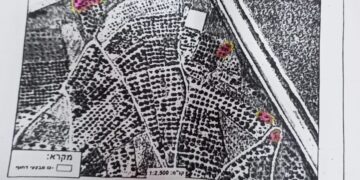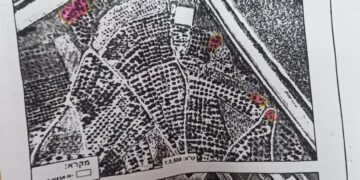On the 28th of October 2015, the Israeli daily newspaper, “Israel Hayom”, published on its website three announcements stating the confiscation of 102 dunums of Palestinian lands in Bethlehem Governorate, located within the illegally and unilaterally defined Jerusalem Municipal boundary of 1967, for public purposes. The announcements, which were signed by the Israeli Finance Minister, Moshe Kahlon, on the 4th of August 2015, were cited as “announcement of the intention to acquire the rights of land and land ownership, required under emergency regulations, for public purposes (with reference to section 5 and section 7 of the Land (Acquisition for Public purposes) Ordinance No. 24 of 1943)”. The published announcements target land in Bethlehem, Beit Jala and Beit Sahour cities and state that the acquisition of land is “necessary due to the continuous attacks against the Israeli security in the area around Jerusalem, and to maintain the separation wall which addresses the security threats, and to protect the national security”. Table 1 gives more details of the published Announcements.
|
Table 1: Targeted locations in Bethlehem Governorate as stated in the published Ads |
|||||
| No. | Community Name | Area (Dunums) | Targeted location | Years of land Acquisition | Plan No. |
| 1 | Beit Sahour | 28.15 | Har Homa – Beit Sahour | 10 | הפ/א/ 322/156 |
| 2 | Bethlehem | 3.129 | North of Gilo 300 Crossing | 8 | ——– |
| 3 | Beit Jala | 70.28 | North of Bethlehem city. | 10 | הפ/א/ 322/155 |
| The tunnel area, north of Beit Jala city | |||||
| Total | 101.6 | ||||
| Source of Ads: “Israel Hayom” Israeli Newspaper[1] | |||||
According to the announcements, Palestinian land owners have the right to file their objections against the land acquisition announcements within 60 days of their publication in the newspaper (Israel Hayom: 28 October 2015) to the secretary of the advisory committee of the Israeli Finance Minister at the Israel Land Administration office in Jerusalem. Announcements’ details below
(1) Plan Number הפ/א/322/152 : This plan targets a land area north of Gilo 300 crossing border, opposite to the Tantur Ecumenical Institute, on the main road linking Bethlehem with Jerusalem city. The targeted area is referred to as “Khallet As Saqa” (As Saqa Hamlet). During the last few years, there has been some construction activity in the area and its surroundings which included on-site Infrastructure and the addition of a number of caravans. The Israeli Minister plans to obtain the right of possession and use of land for a period of eight years. Photo 1
(2): Plan Number הפ/א/322/155: This plan targets two locations, the first comes along the path of the Israeli Segregation Wall east of Gilo (300) border crossing and extending towards the crossing itself. The Israeli occupation authorities intend to fortify the existing section of the Israeli Segregation Wall.
While the second targeted location is close to the tunnel road, on lands of Beit Jala city. The Israeli Authorities intend to fortify the section of the Israeli Segregation Wall which extends from Beit Jala city (in the north) towards the tunnel road[2] that penetrates deep inside the lands of Beit Jala city, and most specifically, on lands of Bir Onah neighborhood. The Israeli Minister plans to obtain the right of possession and use of the land for a period of ten years. Photo 2
(3) Plan No. הפ/א/322/156: it targets Palestinian owned lands near Har Homa settlement, from its southeastern side, on lands of Beit Sahour. The plan intends to fortify the section of the Israeli Segregation Wall that separates Har Homa settlement from Beit Sahour city. The Israeli finance minister plans to obtain the right of possession and use of the targeted land for ten years. Photo 3
Map 1:the targeted locations in Bethlehem Governorate
Land (Acquisition for Public purposes) Ordinance No. 24 of 1943
The Land (Acquisition for Public Purposes) Ordinance of 1943 was enacted for the first time in Palestine during the British mandate period (1920-1948). Article 3 of the ordinance granted the high commissioner of Palestine that time the authority to confiscate land and the absolute power to acquire any piece of land if it is necessary or expedient for any public purpose. The definition of the term 'public purpose' was defined in article 2 of the same ordinance that is “any purpose certified by the minister of Finance to be a public purpose”. Furthermore, article 20 of the same law allows the confiscation of land for the purpose of expanding an existing road or part of it or to construct a road or a stadium or a public park; Additionally, land owners are not entitled to claim any compensation for the confiscation of their land, unless the area of the confiscated land is more than a quarter of the total land area. If the area of the expropriated/confiscated land exceeds one quarter of the total area of the land, then a land owner is compensated for the portion of the land exceeding the one quarter.
After 1948:
Following the declaration of the establishment of the State of Israel in May 1948, Israel embarked on manipulating laws that were active during the British Mandate, especially those related to land and property, in order to ensure its sustainability in the area, through the confiscation of land and construction of settlements and the imposition of facts on the ground. Among the laws that were exploited by Israel to confiscate Palestinian lands were (1) the Land (Acquisition for Public purposes) Ordinance No. 24 of 1943 and (2) the Law of Absentee Property which was approved by the Israeli Knesset in 1950 where under this law, Israel confiscated properties of Palestinians who were regarded as "absent[3]" by the Israeli Government that time and later transferred their properties under the custodian of absentee property authority; in addition to (3) the 1949 Emergency Regulations (Security Zones), through which Israel was able to declare vast areas of land that was owned by Palestinians that time as "closed or security zones" and denied them access to the land; and other laws that were used by the state of Israel on a large scale and were later amended to fit the Israeli colonial project since 1948 and until the date of this report.
Following the 1967
Following the Israeli occupation of the Palestinian territory (the West Bank including East Jerusalem and the Gaza Strip) in 1967, Israel issued a number of laws and orders that aimed at annexing the city of Jerusalem to the borders of the State of Israel; other Israeli laws were also amended for that purpose.
With regard to Jerusalem city, Israel amended the Law and Administration ordinance No. 1 of 1948[4] to integrate the eastern part of Jerusalem city to the municipal and administrative spheres. The amendment was cited as “Law and Administration Ordinance (Amendment No. 11B), 27 June 1967, “Municipal Corporation Ordinance (Amendment) Law, 1967” and stated that: “The law, jurisdiction and administration of the State shall extend to any area of Eretz Israel designated by the Government by order." The next day, on the 28th of June 1967, the Israeli Government passed a law entitled “Law and Administration Ordinance No. 1 of 1967” on East Jerusalem through which it proclaimed the enlargement of the municipal area of Jerusalem city to include East Jerusalem, which was under the Jordanian rule before the 1967 war.
Israel amends the Land (Acquisition for Public purposes) Ordinance No. 24 of 1943
On the 10th of February 2010, the Israeli Knesset[5] passed an amendment to the Land (Acquisition for Public Purposes) Ordinance No. 24 of 1943. The amendment aimed primarily to confirm Israel’s ownership of the confiscated/expropriated land from Palestinians even if the (confiscated/expropriated) land hasn’t been used by Israel for the purpose it was originally confiscated. Additionally, the passed amendment states that Israel has the right not to use the confiscated/expropriated land for the purpose it was confiscated for 17 years[6]. It also prevents Palestinian landowners from demanding to restore their confiscated/expropriated land which hasn’t been used for the purpose it was originally confiscated, if ownership of the land has been transferred to a third party or if more than 25 years have passed since its confiscation from its landowner.[7]
The new amendment also broadens the authority of the finance Minister especially when it comes to the definition of public purposes where it allows the Finance minister to change the purpose of the confiscation/expropriation or even announce about a new purpose if the primary purpose of the confiscation/expropriation hasn’t been achieved. This includes the establishment of new towns and the expansion or development of existing towns.
To sum up,
Israel has dramatically accelerated its settlement program over the years of occupation in blatant violations of all accepted International rules and norms. Additionally, the Segregation Wall is squeezing the growing Palestinian population into ever smaller enclaves and creating conditions for continued enmity and conflict in the region. Thus, by forcing facts on the ground and is destroying any possibility of fruitful negotiations to reach a peace agreement based on a two-state solution, with Jerusalem as the capital of both states. Israel’s latest confiscation announcements are strictly forbidden by the various International Laws and Conventions, some of which are listed below,
- The Fourth Geneva Convention of 1949, Article 49, and paragraph 6 of which states: 'The occupying power shall not deport or transfer parts of its own population into the territories it occupies.'
- Article 53 of the Convention also prohibits 'any destruction by the occupying Power of real or personal property belonging individually or collectively to private persons, or to the State, or to other public authorities, or to social or cooperative organizations, is prohibited, except where such destruction is rendered absolutely necessary by military operations.'
- The Hague Regulations of 1907, Article 23 of which prohibits the destruction or seizure of occupied property, unless it is imperatively demanded by military necessity.
- United Nations Security Council Resolution 242 (1967) which requires Israeli armed forces to withdraw from 'the territories occupied' in the 1967 war, including the West Bank and Gaza Strip.
- United Nations Security Council Resolution 465 (1980) which 'Determines that all measures taken by Israel to change the physical character, demographic composition, institutional structure of status of the Palestinian and other Arab territories occupied since 1967, including Jerusalem, or any part thereof, have no legal validity and that Israel's policy and practices of setting parts of its population and new Immigrants in those territories constitute a flagrant violation of the fourth Geneva convention relative to the protection of civilian persons in time of war and also constitute a serious obstruction to achieving a comprehensive, just and lasting peace in the Middle East.'
- The universal Declaration of Human Rights Adopted and proclaimed by General Assembly resolution 217 A (III) of, December 10, 1948, Article 17 reads that 'No one shall be arbitrarily deprived of his property.' Which means it bans Israel from destroying or confiscating the property of the Palestinians at any case.
[1] The announcements published by Israel Hayom newspaper
http://digital-edition.israelhayom.co.il/Olive/ODE/Israel/Default.aspx?href=ITD%2F2015%2F10%2F28
[2] The tunnel road is part of the Israeli bypass road No. 60 which links Israeli settlements in Jerusalem area with those in Bethlehem and Hebron Governorates.
[3]ABSENTEES' PROPERTY LAW, 5710-1950*
https://unispal.un.org/DPA/DPR/unispal.nsf/3d14c9e5cdaa296d85256cbf005aa3eb/e0b719e95e3b494885256f9a005ab90a?OpenDocument
[4] LAW AND ADMINISTRATION ORDINANCE, No. 1 of 5708-1948*
http://www.israellawresourcecenter.org/israellaws/fulltext/lawandadministrationord.htm
[5] Israeli Knesset
https://en.wikipedia.org/wiki/Knesset
[6] Land (Acquisition for Public Purposes) Ordinance – Amendment No. 10
http://www.adalah.org/en/law/view/502
[7] Knesset Enacts New Amendment to the Land Ordinance of 1943 to Block Palestinian Claims for Land Previously Confiscated by the State
http://www.adalah.org/en/content/view/7677
Prepared by:
The Applied Research Institute – Jerusalem


















